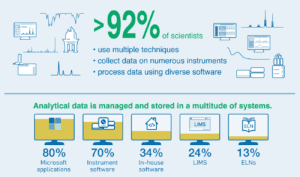July 27, 2023
by Jesse Harris, Digital Marketing Coordinator, ACD/Labs

Software and data are rapidly changing the field of chemistry. Between advanced analytical data processing tools, machine learning algorithms, and automation, research done at state-of-the-art facilities has changed substantially in the last 30 years. Pharmaceutical companies and chemical manufacturers are looking for ways to improve the efficiency of their research using technology.
As industry stays at the cutting edge of technology, has academia kept up? In most cases, the answer is “no”. Chemistry education today often looks the same as it did 10, 20, or even 30 years ago. While the fundamentals of science are as important as ever, students also need to develop a broad technological skillset to help them meet the needs of industry. This includes experience with:
- Managing chemical data
- Working with machine learning and automation
- Practicing green chemistry
Managing Chemical Data—Moving Beyond Microsoft
All labs must efficiently collect, manage, access, and store data. 92% of respondents to our 2022 Analytical Data Management Report said they need analytical data on a daily basis, but 68% said that data was difficult to access and share. Where is this data being stored? 80% of respondents said they use Microsoft applications. These applications weren’t designed for chemistry data, making it time-consuming for scientists to collect, interpret, and share that data.

Many research organizations are improving efficiency by adopting analytical data management systems or cloud-based solutions. When data is easily accessible across an organization, chemists can review each other’s experiment data to uncover insights.
To prepare for industry-level pharmaceutical and chemical research laboratories, students must learn to manage analytical data outside of Excel spreadsheets and Word documents. Universities can offer students this experience by deploying chemistry software, cloud-based applications, and analytical data management systems that are user-friendly and support better productivity.
Introducing Students to Data Science, Machine Learning, and Automation
Machine learning and data science are already impacting lab workflows, and this will only grow in the years ahead. Data science is one of the most in-demand skills for students graduating from universities, and many companies are already using artificial intelligence to support drug discovery.
However, there is no ChatGPT for chemistry. The machine learning and data science models used in the pharmaceutical and chemical industries are not plug-and-play tools. They need a steady diet of high-quality information to be valuable. Students should learn about the importance of digitalizing and harmonizing analytical data to supply machine learning and data science applications with the reliable data they need to deliver actionable insights.
Automation is another growing trend in the pharmaceutical and chemical industries. Researchers can use automation to eliminate or simplify the most tedious and time-consuming lab workflows. While students need to be familiar with each step in their laboratory workflows, they should also learn about the hardware and software involved in automation. For example, high throughput experimentation (HTE) is a type of chemistry where many small-scale reactions run in parallel. This includes adding reagents to the wells of a plate, performing a chemical conversion, and analyzing the results. HTE is done with the help of robots and software such as Katalyst D2D. Experience with these tools will help enable the automated labs of the future.
In addition to preparing students for the workforce, this also allows the students to spend less time measuring out reagents or cleaning glassware. That time can be spent completing more experiments, interpreting their results, or engaging with the scientific literature.
Green Chemistry Technology and Chemistry Education
Fighting climate change and environmental degradation are some of the most pressing concerns for the 21st century. Between petrochemicals, plastics, and pesticides, chemists have a massive environmental impact. Chemical synthesis often has an enormous carbon footprint, as exemplified by the pharmaceutical industry, which is more emissions-intensive than the automotive industry.
If we want the world to be habitable in the future, today’s students need to learn and adopt the principles of green chemistry and understand how they can be implemented. Use of predictive software can help reduce the number of experiments that need to be run, saving considerable resources and reducing waste.
Method Selection Suite is an excellent example of this. Chromatographic methods often require many experiments, leading to massive volumes of waste solvents. Method Selection Suite helps chemists efficiently explore a wide range of solvents to help uncover the methods without mindless trial-and-error. Not only that, it is also helpful for finding methods that avoid using environmentally hazardous solvents.
Students can also practice using chemical property predictors. Tools such as Tox Suite allow chemists to use chemical structures to predict aquatic toxicity, mutagenicity, hERG inhibition, and more. Familiarity with this type of software will help chemists think deeply about environmental impact and will help them develop safer products in the future.
Chemistry Education and the Future
Chemists will probably always need to learn fundamental laboratory skills. Hands-on experience measuring reagents, running reactions, and performing extractions is foundational for understanding chemistry.
But while these legacy techniques are still essential, more is needed. Today’s chemistry education must be preparing students for the coming wave of digital innovation and be equipped to meet the needs of society. Providing access to chemistry software is one of the best ways to meet these objectives.


